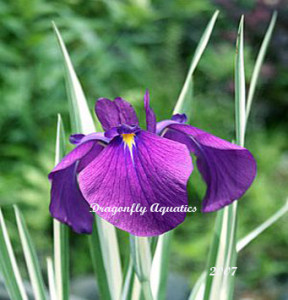I'm not certain of the identity of this butterfly. I thought perhaps it was a male Eastern Tiger Swallowtail. I'm really not certain, although it sure liked my dwarf crab-apple tree. It came back day after day.....I'm thinking it was the same one.
I know we don't want to think about it but it won't be long and fall will be here and we all know what comes next.....its time for us to be thinking about taking the extra care with our pond plants to make them comfortable for the winter cold. I've noticed the butterflies aren't as plentiful as they had been but occassionally I'm able to catch one.
HARDY BOG/MARGINAL PLANTS
Once your hardy marginal plants begin to brown, usually after the first hard frost, prune back excess foliage and discard any decaying material, so it does not compromise the water quality over the winter months. Potted bog plants such as Pickeral, Thalia Dealbata, and Japanese Variegated Iris should be placed at a sufficient depth to avoid freezing the crown of the plant. Most of the other hardy bog plants can be left as they are and will return the following spring.
Tropical Bog Plants
Many of the tropical bog plants will winter well indoors in a sunny window or with a grow light. They do not need to be submerged in water. Keep the soil constantly moist by placing the potted plants in a tray of water.
 Water Iris create a natural look to your pond and provide brilliant colors in the spring. They usually bloom between May and July depending upon cultivator and climate. Different varieties bloom at different times. There are certain cultivator that even re-bloom again in the fall if in a climate they like. Irises come in every color of the rainbow. You often see irises along the banks of natural streams and ponds.
Water Iris create a natural look to your pond and provide brilliant colors in the spring. They usually bloom between May and July depending upon cultivator and climate. Different varieties bloom at different times. There are certain cultivator that even re-bloom again in the fall if in a climate they like. Irises come in every color of the rainbow. You often see irises along the banks of natural streams and ponds.
To create a natural look to your pond, place iris along the edges and add marsh marigolds, water lettuce or parrots feather directly in front of the iris. This look softens the water line and contrast well with the iris's larger sword shaped foliage plus they help shade these plants from the direct hot afternoon sun. It will give you a soft relaxing look to your pond's edge. The variegated iris, such as Japanese Variegated Iris or Yellow Variegated Iris add color to create this look.
Irises perform well if they are in full sun. They need at least six hours of sun to grow well and bloom reliably. If you place an iris in a mostly shaded area it is best to give it the morning sun rather than the afternoon sun. The morning sun will help dry up the dew from the plants leaves reducing the risk of bacteria or fungus to your plant.
When planting your iris the crown of your iris should be no more than 3 inches below the water surface. They will grow well in moist soil to water a few inches of the crown. Remove any mulch and debris in the early spring to allow the sun to warm the plant and its soil. You would want to fertilize it early in the spring to help promote growth and blooms. A good rule of thumb would be when your water temperatures reach 65 degrees begin fertilizing and continue once a month up until the first frost. In climates when you don't experience frost you would want to stop fertilizing when the leaves begin to turn brown and start to go dormant.
Iris need minimal attention. You may want to trim off old and unsightly foliage periodically to reduce the risk of diseases and pests. Winter over your iris just by leaving them and trimming off leaves to about an inch or so above the crown of the plant. You want to make sure the plant remains wet during the winter.
The best time for dividing irises depends on your climate. In warmer climates where winters are not cold you would want to do the dividing in the fall after the summer heat. This gives the iris time to recover and grow new roots and leaves prior to going dormant for the winter. In colder climates you can divide when they have finished flowering during the midsummer. This gives them time to recover from the shock of dividing and gives them time to grow new leaves and new roots before going into dormancy. All iris have to go dormant to prepare for the next spring.
Buy Japanese Variegated Iris here.